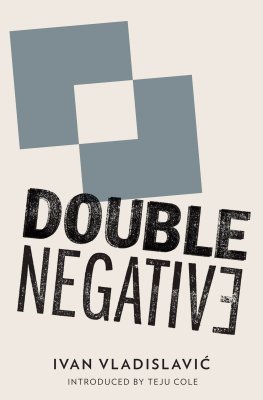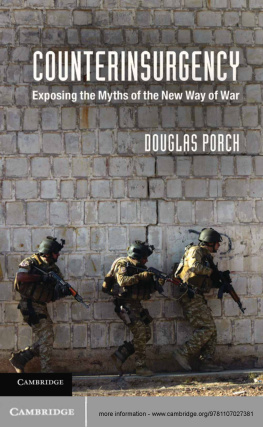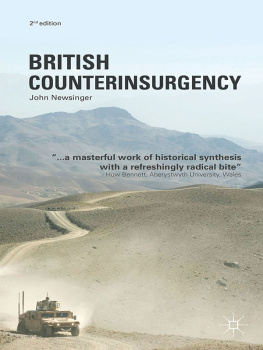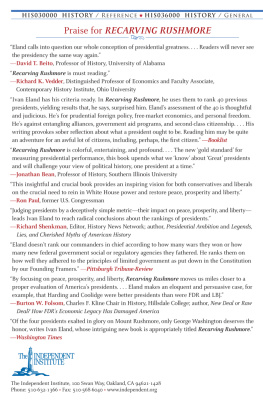Ivan Eland - The Failure of Counterinsurgency
Here you can read online Ivan Eland - The Failure of Counterinsurgency full text of the book (entire story) in english for free. Download pdf and epub, get meaning, cover and reviews about this ebook. year: 2013, publisher: ABC-CLIO, genre: Politics. Description of the work, (preface) as well as reviews are available. Best literature library LitArk.com created for fans of good reading and offers a wide selection of genres:
Romance novel
Science fiction
Adventure
Detective
Science
History
Home and family
Prose
Art
Politics
Computer
Non-fiction
Religion
Business
Children
Humor
Choose a favorite category and find really read worthwhile books. Enjoy immersion in the world of imagination, feel the emotions of the characters or learn something new for yourself, make an fascinating discovery.

- Book:The Failure of Counterinsurgency
- Author:
- Publisher:ABC-CLIO
- Genre:
- Year:2013
- Rating:4 / 5
- Favourites:Add to favourites
- Your mark:
- 80
- 1
- 2
- 3
- 4
- 5
The Failure of Counterinsurgency: summary, description and annotation
We offer to read an annotation, description, summary or preface (depends on what the author of the book "The Failure of Counterinsurgency" wrote himself). If you haven't found the necessary information about the book — write in the comments, we will try to find it.
The Failure of Counterinsurgency — read online for free the complete book (whole text) full work
Below is the text of the book, divided by pages. System saving the place of the last page read, allows you to conveniently read the book "The Failure of Counterinsurgency" online for free, without having to search again every time where you left off. Put a bookmark, and you can go to the page where you finished reading at any time.
Font size:
Interval:
Bookmark:
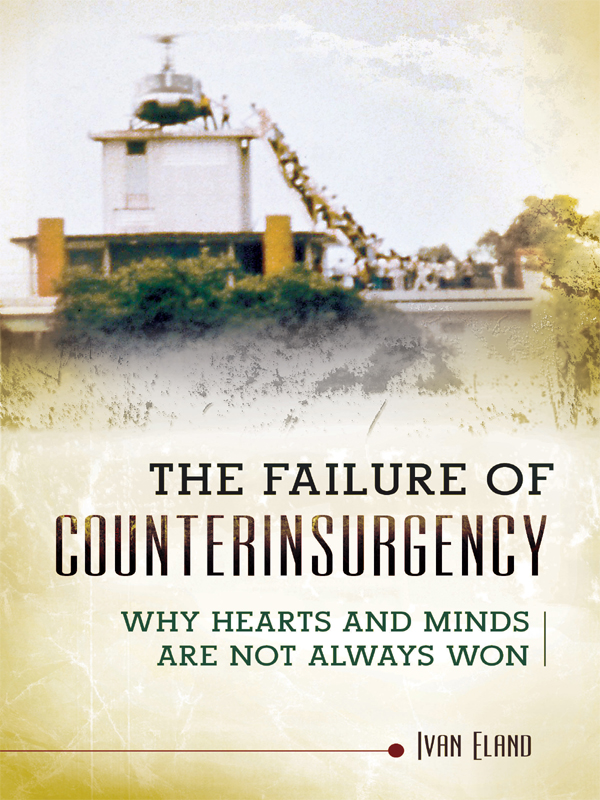
The Failure of Counterinsurgency
The Failure of Counterinsurgency
Why Hearts and Minds Are Seldom Won
IVAN ELAND
Praeger Security International

AN IMPRINT OF ABC-CLIO, LLC
Santa Barbara, California Denver, Colorado Oxford, England
copyright 2013 by Ivan Eland
All rights reserved. No part of this publication may be reproduced, stored in a retrieval system, or transmitted, in any form or by any means, electronic, mechanical, photocopying, recording, or otherwise, except for the inclusion of brief quotations in a review, without prior permission in writing from the publisher.
Library of Congress Cataloging-in-Publication Data
Eland, lvan.
The failure of counterinsurgency : why hearts and minds are seldom won/Ivan Eland.
pages cm. (Praeger security international)
Includes bibliographical references and index.
ISBN 978-1-4408-3009-9 (hardcopy : alk. paper) ISBN 978-1-4408-3010-5 (ebook) 1. Counterinsurgency I. Title.
U241.E53 2013
355.0218dc23 2013008154
ISBN: 978-1-4408-3009-9
EISBN: 978-1-4408-3010-5
17 16 15 14 13 1 2 3 4 5
This book is also available on the World Wide Web as an eBook.
Visit www.abc-clio.com for details.
Praeger
An Imprint of ABC-CLIO, LLC
ABC-CLIO, LLC
130 Cremona Drive, P.O. Box 1911
Santa Barbara, California 93116-1911
This book is printed on acid-free paper 
Manufactured in the United States of America
Contents
CHAPTER 1
Introduction: Quagmire
The Usual Outcome of Counterinsurgency Warfare
Unlike conventional wars between nation-stateswith both sides wearing uniforms and using heavy weapons, such as tanks, artillery, fixed-wing aircraft, and shipsfighting nonuniformed guerrillas in an insurgency that blend back into the civilian population is often a much different and more difficult task. Agile guerrillas often use hit-and-run tactics against isolated or locally inferior counterinsurgency (COIN) units. Insurgents, unlike terrorists, do try to hold ground but will usually retreat or blend back into the civilian population when confronted by superior COIN forces. Also, forces fighting an insurgency often rely less on heavy weapons and mechanized forces and more on infantry and special forces on the ground and helicopters in the air.
After the less-than-stellar outcomes of COIN wars in Afghanistan and Iraq, a debate broke out in the U.S. military about whether expensive, troop-heavy, time-intensive efforts to win over local populations by nation building is dead. Even the proponents of so-called COIN warfare admit that the costs and risks are high. Opponents maintain that an effective national strategy should minimize the blood and treasure expended to achieve policy aims and that a classic COIN approach, to attempt to win the hearts and minds of people in foreign countries, does not measure up. Opponents believe that although COIN can sometimes succeed, it is rarely worth the high costs or long time frames to realize even some results. For example, John Nagla former adviser to General David Petraeus, the former commander of U.S. forces in Iraq and Afghanistan, and author of a frequently cited writing on COIN warfareadmitted
This book, after examining many historical cases of COIN warfare, is probably even more pessimistic than Nagls assessment about the chances for success in those endeavors and fully agrees with him that the United States should usually stay out of such potential quagmires. The vast majority of guerrilla wars have ended with the guerrillas winning militarily, politically, or both. In COIN warfare, the odds are stacked in favor of the weaker guerrillas rather than the more powerful COIN forces. Yet COIN forces, usually stronger in numbers and technology than guerrillas, often overestimate their ability to prevail and thus fail to take advantage of opportunities for a negotiated settlement before its too late. They conflate military victory with political victory. But guerrillas tend to have political objectives and use military tactics as a tool. Military defeat does not promise the end of an insurgency, as so many cases examined in this text indicate, and COIN forces can find themselves making huge political concessions even to a severely weakened opponent that would, in conventional warfare, be considered defeated.
Even in the limited number of episodes in which COIN forces won both militarily and politically, no one factor seems to regularly explain their success. The most significant factor in the outcome of such brushfire wars may be mostly out of the control of COIN forceswhether the guerrillas are able to claim the mantle of national liberators, either against a corrupt or authoritarian government or a foreign occupier. If a foreign occupier is involved, it is almost impossible to prevent the guerrillas from acquiring this image. Even in the case of a local corrupt or authoritarian government, where no foreign occupier is involved, the societal grievances generating the rebellion usually give the insurgents a leg up on acquiring this popular nationalist appeal.
Thus, given all of the advantages guerrillas have in COIN wars, which are explored in this volume, and considering the inconsistency of key factors leading to the rare combined military and political victories for COIN forces, great powers should stay out of guerrilla wars unless their vital interests absolutely require entry. Fortunately, for the United States, its vital interests are only rarely threatened by guerrilla wars abroad, and avoiding them is a very real and viable possibility.
WHAT IS AN INSURGENCY?
According to U.S. military doctrine, an insurgency is an organized movement aimed at the overthrow of a constituted government through the use of subversion and armed conflict. Stated another way, an insurgency is an organized, protracted politico-military struggle designed to weaken the control and legitimacy of an established government, occupying power, or other political authority while increasing insurgent control.
Robert Taber, a journalist and expert on COIN warfare, describes the very different objectives and tactics of guerrillas and COIN forces:
The guerrilla fighter is primarily a propagandist, an agitator, a disseminator of the revolutionary idea, who uses the struggle itselfthe actual physical conflictas an instrument of agitation. His primary goal is to raise the level of revolutionary anticipation, and then of popular participation, to the crisis point at which the revolution becomes general throughout the country and the people in their masses carry out the final taskthe destruction of the existing order and (often but not always) of the army that defends it.
By contrast, the purpose [of] the counterrevolutionary is negative and defensive. It is to restore order, to protect property, to preserve existing forms and interests by force of arms, where persuasion has already failed. His means may be political insofar as they involve the use of still more persuasionthe promise of social and economic reforms, bribes of a more localized sort, counter propaganda of various kinds. But primarily the counterinsurgents task must be to destroy the revolution by destroying its promisethat means by proving, militarily, that it cannot and will not succeed.
The counterinsurgent seeks a military solution: to wipe out the guerrillas. He is hampered by a political and economic impediment: he cannot wipe out the populace, or any significant sector of it. The guerrilla, for his part, wishes to wear down his military opponent and will employ suitable tactics to that end, but his primary objective is political. It is to feed and fan the fires of revolution by his struggle, to raise the entire population against the regime, to discredit it, isolate it, wreck its credit, undermine its economy.
Next pageFont size:
Interval:
Bookmark:
Similar books «The Failure of Counterinsurgency»
Look at similar books to The Failure of Counterinsurgency. We have selected literature similar in name and meaning in the hope of providing readers with more options to find new, interesting, not yet read works.
Discussion, reviews of the book The Failure of Counterinsurgency and just readers' own opinions. Leave your comments, write what you think about the work, its meaning or the main characters. Specify what exactly you liked and what you didn't like, and why you think so.


